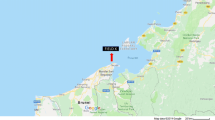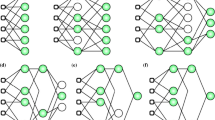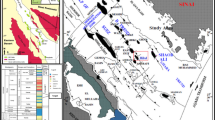Abstract
Increase in seismic events around the world has necessitated the evaluation of soil liquefaction potential since it adversely influences the stability of adjacent structures and poses a threat to lives and property. The first step in evaluating the liquefaction potential involves the estimation of the in situ state of sand and the state parameter as an index to characterize the behavior of sand. Due to the difficulty in obtaining high-quality undisturbed sandy samples for laboratory testing and evaluation, simplified equations based on the cone penetration test (CPT) are used for reasonable estimation of field behavior. In the present study, an optimized group method of data handling (GMDH)-type neural network was proposed to estimate the state parameter from CPT data obtained from the historical liquefaction database. A comparison was made between the measured and the predicted values of the state parameter to evaluate the performance of the proposed GMDH neural network method. A sensitivity analysis of the proposed model was also carried out to study the effect of input variables on the output variable of the proposed model. Additionally, the evaluation of in situ state and liquefaction potential of sand based on the state parameter was also presented and compared with the existing methods. Overall, the use of the GMDH model in evaluating the in situ state of sand and subsequent liquefaction potential assessment has shown promising results.
















Similar content being viewed by others
References
Been K, Jefferies MG (1985) A state parameter for sands. Géotechnique 35(2):99–112
Been K, Crooks JHA, Becker DE, Jefferies MG (1986) The cone penetration test in sands: part I, state parameter interpretation. Géotechnique 36(2):239–249. https://doi.org/10.1680/geot.1986.36.2.239
Been K, Jefferies MG, Crooks JHA, Rothenburg L (1987) The cone penetration test in sands: part II, general inference of state. Géotechnique 37(3):285–299
Been K, Crooks JHA, Jefferies MG (1988) Interpretation of material state from the CPT in sands and clays. In: Penetration testing in the UK. Thomas Telford, London, pp 89–92
Been K, Jefferies MG (1992) Towards systematic CPT interpretation. In: Predictive soil mechanics: in proceedings of the wroth memorial symposium, 27–29 July 1992, pp 121–134
Boulanger RW, Idriss I M. 2014. CPT and SPT based liquefaction triggering procedures. Report No. UCD/CGM.-14, 1
Cai G, Liu S, Puppala AJ (2012) Liquefaction assessments using seismic piezocone penetration (SCPTU) test investigations in Tangshan region in China. Soil Dyn Earthq Eng 41:141–150
Chittoori B, Puppala AJ (2011) Quantitative estimation of clay mineralogy in fine-grained soils. J Geotech Geoenviron Eng 137(11):997–1008
Duan W, Cai G, Liu S, Yuan J, Puppala AJ (2019) Assessment of ground improvement by vibro-compaction method for liquefiable deposits from in-situ testing data. Int J Civ Eng 17(6):723–735
Duan W, Cai G, Liu S, Puppala AJ, Chen R (2019) In-situ evaluation of undrained shear strength from seismic piezocone penetration tests for soft marine clay in Jiangsu, China. Transp Geotech 20:100253
Duan W, Congress SSC, Cai G, Liu S, Dong X, Chen R, Liu X (2021) A hybrid GMDH neural network and logistic regression framework for state parameter-based liquefaction evaluation. Can Geotechn J. https://doi.org/10.1139/cgj-2020-0686
Ebtehaj I, Bonakdari H, Zaji AH, Azimi H, Khoshbin F (2015) GMDH-type neural network approach for modeling the discharge coefficient of rectangular sharp-crested side weirs. Eng Sci Technol Int J 18(4):746–757
Ghafghazi M, Shuttle D (2008) Interpretation of sand state from cone penetration resistance. Géotechnique 58(8):623–634
Goh AT (2002) Probabilistic neural network for evaluating seismic liquefaction potential. Can Geotech J 39(1):219–232
Ivakhnenko AG (1971) Polynomial theory of complex systems. IEEE Trans Syst Man Cybern 1(4):364–378
Jamiolkowski M, Lo Presti DCF, Manassero M (2003) Evaluation of relative density and shear strength of sands from cone penetration test and flat dilatometer test. In: Soil Behavior and Soft Ground Construction (GSP119), ASCE, Reston, VA, pp 201–238
Jefferies MG, Davies MP (1991) Soil classification by the cone penetration test: discussion. Can Geotech J 28(1):173–176
Jefferies MG, Davies MP (1993) Use of CPTU to estimate equivalent SPT N 60. Geotech Test J 16(4):458–468
Jefferies MG, Been K (2006) Soil liquefaction: a critical state approach. CRC Press
Juang CH, Lu PC, Chen CJ (2002) Predicting geotechnical parameters of sands from CPT measurements using neural networks. Comput Aided Civ Infrastruct Eng 17(1):31–42
Juang CH, Chen CH, Mayne PW (2008) CPTU simplified stress-based model for evaluating soil liquefaction potential. Soils Found 48(6):755–770
Juang CH, Hsieh Y, Ching J, Ku C (2012) Unified CPTu-based probabilistic model for assessing probability of liquefaction of sand and clay. Géotechnique 62(10):877
Kohestani VR, Hassanlourad M (2015) Modeling the mechanical behavior of carbonate sands using artificial neural networks and support vector machines. Int J Geomech 16(1):04015038
Kordnaeij A, Kalantary F, Kordtabar B, Mola-Abasi H (2015) Prediction of recompression index using GMDH-type neural network based on geotechnical soil properties. Soils Found 55(6):1335–1345
Kulhawy FH, Mayne PW (1991) Relative density, SPT, and CPT interpretations. In: Proc., 1st Int. Symposium on Calibration Chamber Testing, Potsdam, NY, Elsevier, Amsterdam, pp 197–211
Ku CS, Juang CH, Chang CW, Ching J (2011) Probabilistic version of the Robertson and Wride method for liquefaction evaluation: development and application. Can Geotech J 49(1):27–44
Liong SY, Lim WH, Paudyal GN (2000) River stage forecasting in Bangladesh: neural network approach. J Comput Civ Eng 14(1):1–8
López I, Aragonés L, Villacampa Y (2018) Modelling the cross-shore profiles of sand beaches using artificial neural networks. Mar Georesour Geotechnol 37:683–694
Madala HR, Ivakhnenko AG (1994) Inductive learning algorithms for complex systems modeling, vol 368. CRC Press, Boca Raton
Mirjalili S (2016) SCA: a sine cosine algorithm for solving optimization problems. Knowl Based Syst 96:120–133
Moayed RZ, Kordnaeij A, Mola-Abasi H (2017) Compressibility indices of saturated clays by group method of data handling and genetic algorithms. Neural Comput Appl 28(1):551–564
Mohammadzadeh D, Bazaz JB, Alavi AH (2014) An evolutionary computational approach for formulation of compression index of fine-grained soils. Eng Appl Artif Intell 33:58–68
Mola-Abasi H, Eslami A (2019) Prediction of drained soil shear strength parameters of marine deposit from CPTu data using GMDH-type neural network. Mar Georesour Geotechnol 37:180–189
Moss RES (2003) CPT-based probabilistic assessment of seismic soil liquefaction initiation. Ph.D. dissertation, University of California, Berkeley, Cal
Moss RES, Seed RB, Kayen RE, Stewart JP, Der Kiureghian A, Cetin KO (2006) CPT-based probabilistic and deterministic assessment of in situ seismic soil liquefaction potential. J Geotech Geoenviron Eng 132(8):1032–1051. https://doi.org/10.1061/(ASCE)1090-0241(2006)132:8(1032)
Moss RES, Kayen R, Tong L, Songyu L, Cai G, Wu J (2009) Reinvestigation of liquefaction and nonliquefaction case histories from the 1976 Tangshan earthquake. In: Pacific Earthquake Engineering Research Center, Berkeley, Calif. PEER Report No. 2009/102, August. https://peer.berkeley.edu/publication/peer_reports_2009/reports_2009.html
Moss RES, Kayen RE, Tong LY, Liu SY, Cai GJ, Wu J (2011) Retesting of liquefaction and nonliquefaction case histories from the 1976 Tangshan Earthquake. J Geotech Geoenviron Eng 137(4):334–343. https://doi.org/10.1061/(ASCE)GT.1943-5606.0000406
Naeini SA, Moayed RZ, Kordnaeij A, Mola-Abasi H (2018) Elasticity modulus of clayey deposits estimation using group method of data handling type neural network. Measurement 121:335–343
Nariman-Zadeh N, Darvizeh A, Ahmad-Zadeh GR (2003) Hybrid genetic design of GMDH-type neural networks using singular value decomposition for modelling and prediction of the explosive cutting process. Proc Inst Mech Eng Part B J Eng Manuf 217(6):779–790. https://doi.org/10.1243/09544050360673161
Plewes HD, Davies MP, Jefferies MG (1992) CPT based screening procedure for evaluating liquefaction susceptibility. In: Proceedings of the 45th Canadian Geotechnical Conference, Toronto, Ont., 26–28 October 1992, pp 41–49
Reid D (2014) Estimating slope of critical state line from cone penetration test—an update. Can Geotech J 52(1):46–57
Robertson PK, Campanella RG (1983) Interpretation of cone penetration tests part I: Sand. Can Geotech J 20(4):718–733
Robertson PK, Wride CE (1998) Evaluating cyclic liquefaction potential using the cone penetration test. Can Geotech J 35(3):442–459
Robertson PK (2008) Discussion of “Liquefaction potential of silts from CPTu.” Can Geotech J 45(1):140–141
Robertson PK (2009) Performance based earthquake design using the CPT. In: Proceedings of IS-Tokyo 2009: international conference on performance-based design in earthquake geotechnical engineering—from case history to practice, Tokyo, Japan, 15–18 June 2009. CRC Press/Balkema, Leiden, The Netherlands, pp 3–20
Robertson PK (2009) Interpretation of cone penetration tests—a unified approach. Can Geotech J 46(11):1337–1355
Robertson PK (2010) Estimating in-situ state parameter and friction angle in sandy soils from CPT. In: 2nd International Symposium on Cone Penetration Testing, Huntington Beach, CA, USA
Schnaid F, Yu HS (2007) Interpretation of the seismic cone test in granular soils. Géotechnique 57(3):265–272
Shuttle DA, Cunning J (2007) Liquefaction potential of silts from CPTu. Can Geotech J 44(1):1–19
Shuttle DA, Cunning J (2008) Reply to the discussion by Robertson on “Liquefaction potential of silts from CPTu.” Can Geotech J 45(1):142–145
Tarefder RA, Ahsan S, Ahmed MU (2015) Neural network–based thickness determination model to improve backcalculation of layer moduli without coring. Int J Geomech 15(3):04014058
Vissikirsky VA, Stepashko VS, Kalavrouziotis IK, Drakatos PA (2005) Growth dynamics of trees irrigated with wastewater: GMDH modeling, assessment, and control issues. Instrum Sci Technol 33(2):229–249
Wang Y, Akeju O (2016) Quantifying the cross-correlation between effective cohesion and friction angle of soil from limited site-specific data. Soils Found 56(6):1055–1070
Wride CE, Robertson PK, Biggar KW, Campanella RG, Hofmann BA, Hughes JM, Woeller DJ (2000) Interpretation of in situ test results from the CANLEX sites. Can Geotech J 37(3):505–529
Yang J, Liu X, Guo Y, Liang L (2018) A unified framework for evaluating in situ state of sand with varying fines content. Géotechnique 68(2):177–183
Youd TL, Idriss IM (2001) Liquefaction resistance of soils: summary report from the 1996 NCEER and 1998 NCEER/NSF workshops on evaluation of liquefaction resistance of soils. J Geotech Geoenviron Eng 127(4):297–313
Zhang N, Zou H, Zhang L, Puppala AJ, Liu S, Cai G (2020) A unified soil thermal conductivity model based on artificial neural network. Int J Therm Sci 155:106414
Zhao Z, Duan W, Cai G (2021) A novel PSO-KELM based soil liquefaction potential evaluation system using CPT and Vs measurements. Soil Dyn Earthq Eng 150:106930. https://doi.org/10.1016/j.soildyn.2021.106930
Zhao Z, Congress SSC, Cai G, Duan W (2021) Bayesian probabilistic characterization of consolidation behavior of clays using CPTU data. Acta Geotech. https://doi.org/10.1007/s11440-021-01277-8
Zhou SG, Guo LJ (1979) Liquefaction Investigation in Lutai District. Ministry of Railway, China (in Chinese)
Zhou SG, Zhang SM (1979) Liquefaction Investigations in Tangshan District. Ministry of Railway, China (in Chinese)
Acknowledgements
The majority of the work presented in this paper was funded by the National Key R&D Program of China (2020YFC1807200), the National Natural Science Foundation of China (Grants Nos. 52108332, 41877231 and 42072299), the Project funded by China Postdoctoral Science Foundation (No. 2021M702421). These financial supports are gratefully acknowledged.
Author information
Authors and Affiliations
Corresponding authors
Additional information
Publisher's Note
Springer Nature remains neutral with regard to jurisdictional claims in published maps and institutional affiliations.
Appendix: CPTU-related parameters
Appendix: CPTU-related parameters
-
qc raw CPT cone resistance (generally in MPa, but may need to convert into kPa when used with other parameters to derive dimensionless parameters such as Q and qt1N)
-
qt corrected cone resistance (=qc+(1-a)u2)
-
a area ratio of cone used (in this paper, a = 0.85)
-
u2 penetration in situ pore pressure (kPa)
-
fs sleeve friction (kPa)
-
σ′vo vertical effective overburden stress (kPa)
-
σvo vertical total overburden stress (kPa)
-
Bq pore pressure parameter (= excess pore pressure ratio = (u2-u0)/(qt-σvo).
-
u0 hydrostatic water pressure (kPa).
-
Q normalized cone resistance (= (qc- σvo)/ σ′vo) for CPT or (= (qt- σvo)/ σ′vo) for CPTU.
-
Rf friction ratio = ((fs/qc) × 100%).
-
Fr normalized friction ratio = [fs = (qt-σvo)] × 100%
-
Ic,BJ soil behavior-type index defined by Been & Jefferies [5]
-
Ic,RW soil behavior-type index defined by Robertson &Wride (1998)
$$I_{{\text{c, RW}}} = \sqrt {\left( {3.47 - \lg Q} \right)^{2} + \left( {1.22 + \lg F_{{\text{r}}} } \right)^{2} }$$
-
qc1N adjusted cone tip resistance for CPT = [(qc -σvo)/ p0](p0/σ′vo)n.
-
qt1N adjusted cone tip resistance for CPTU = [(qt -σvo)/ p0](p0/σ′vo)n.
-
p0 reference pressure (= 100 kPa).
-
n stress exponent = 0.381 Ic,RW + 0.05(σ′vo/p0)-0.15 (n ≤ 1).
-
qc1N,cs is equivalent clean sand cone tip resistance for CPT = Kc × qc1N.
-
qt1N,cs is equivalent clean sand cone tip resistance for CPTU = Kc × qt1N.
-
Kc is a correction factor that is a function of soil behavior-type index Ic, RW
-
$$K_{{\text{c}}} {\text{ = }}\left\{ {\begin{array}{*{20}l} {1,} \hfill & {{\text{if }}\, I_{{c,\, {\text{RW}}}} \le 1.64} \hfill \\ { - 0.403I_{{{\text{c,}}\, {\text{RW}}}}^{{\text{4}}} {\text{ + }}5.58I^{3} _{{{\text{c,}}\, {\text{RW}}}} - 21.63I_{{{\text{c,}}\, {\text{RW}}}}^{{\text{2}}} + 33.75I_{{{\text{c,}}\, {\text{RW}}}} - 17.88,} \hfill & {{\text{if }}\, I_{{{\text{c,}}\, {\text{RW}}}} > 1.64} \hfill \\ \end{array} } \right.$$
Rights and permissions
About this article
Cite this article
Duan, W., Congress, S.S.C., Cai, G. et al. Prediction of in situ state parameter of sandy deposits from CPT measurements using optimized GMDH-type neural networks. Acta Geotech. 17, 4515–4535 (2022). https://doi.org/10.1007/s11440-022-01540-6
Received:
Accepted:
Published:
Issue Date:
DOI: https://doi.org/10.1007/s11440-022-01540-6




